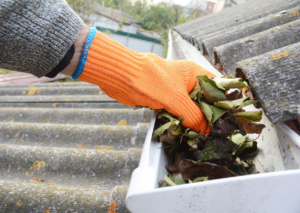Keeping your gutters clean is an important part of protecting your home. Clogged gutters can lead to leaky roofs, rotting fascia, mold growth, and foundation damage.
Gutter Cleaning is a difficult chore that can be made easier by using specialized tools. Some of the most useful tools include rakes, handheld blowers, and extension poles.

Gutter cleaning is one of the many tasks that comes with homeownership. The task is important for a number of reasons, including the fact that it reduces the risk of water damage to roofs and foundations. It also prevents pest infestations and keeps the house looking great. The job is not without its dangers, however, and it is recommended that homeowners hire a professional service to do the work for them.
There are a number of things that can go wrong when cleaning gutters, and the consequences can be severe. Those who attempt to do the job themselves should wear gloves and safety glasses to protect their hands and eyes from debris and other hazards. They should also use a sturdy ladder that is placed on a level surface. Lastly, they should place a drop cloth below each section of the gutter to catch any fallen debris.
The most common mistake made by those trying to clean their own gutters is overreaching. This can cause them to lose balance and fall off the ladder or roof. It is best to follow the three-points-of-contact rule: Both legs and one hand should be firmly on the ladder at all times.
Another potential hazard is using metal tools to remove gutter debris. This can damage the gutters and scratch or chip the paint. A hose should be used to spray down the gutters, and a pistol-grip nozzle is preferred to allow for control of water pressure with the other hand. A bucket should be used to collect debris and a garden shovel or drain clearing tool is helpful for removing clogs.
Gutters are designed to channel water away from the house. However, if the gutters become clogged with leaves, dirt and other debris, the water can flow over the sides of the home and cause significant damage to the roof and foundation. Regular gutter cleaning can eliminate this problem and ensure that the gutters are properly functioning. It also helps to keep down the cost of maintenance by preventing the need for repair and replacement.
Gutter Cleaning Costs
Gutter cleaning is an essential home maintenance task, helping to prevent clogs, which can lead to water damage and other structural issues. In addition, clogged gutters can attract pests, such as rats and mosquitoes, and create dangerous mold and mildew. Gutter cleaning is also a great way to extend the lifespan of your roof and minimize basement flooding and other problems.
The cost of gutter cleaning varies, depending on the type of home and the condition of the gutters. For example, it is usually cheaper to clean the gutters of a single-story home than a two- or three-story home. This is because it is harder and more risky to climb higher up on a multistory house. Additionally, if your gutters are heavily clogged, it may take longer to clean them than if they were clearer.
Many professional gutter cleaners charge by the linear foot, so the length of your gutters will affect the price. A typical rate is $0.95 to $1.25 per linear foot for a one-story home and $0.80 to $2 per linear foot for a two-story home. This pricing method makes it easy to compare prices from different companies and ensures that you are getting the best value for your money.
Some gutter cleaning companies may also charge extra for travel fees, which can be a significant amount of money if your home is located in an outlying area or has challenging terrain. Also, if you are having your gutters cleaned during the peak season, you can expect to pay more than during other times of the year.
Some gutter companies also offer a variety of other services, including shingle cleaning and window washing, and these can add to the overall cost. It is important to find a company that offers these services and is licensed, insured, and bonded before hiring them to complete any work on your home. Otherwise, you could be at risk of being scammed by unlicensed and inexperienced workers who do not follow safety procedures. In addition, these unlicensed workers may not be properly insured and could leave you with significant liability issues if they were to fall from your gutters during the cleaning process.
Gutter Cleaning Methods
Gutter cleaning professionals can efficiently remove gutter debris with a garden hose or power washer attachment. This method works well for most homes and quickly removes packed dirt and leaves as well as clogged downspouts. Gutter cleaning services also test downspouts to ensure they’re clear and draining properly. In addition, gutter cleaners clean up any debris that falls to the ground and dispose of it properly.
Clogged and overflowing gutters can cause a variety of problems for homeowners including leaky basements, rotted fascia boards, roof sheathing, and shingle damage. They can also encourage the growth of mildew and mold, which can trigger respiratory disorders. Gutter cleaning prevents these issues by ensuring that rainwater and snow melt are funneled away from the house, preventing water from overflowing and seeping through the ceiling and walls.
A well-maintained gutter system also helps extend the life of your roof. It prevents water and ice from building up on your roof and shifts the weight of the shingles away from the eaves, which can cause them to pull apart and crack over time. It also ensures that shingles aren’t damaged by heavy snow and ice loads and helps prevent the formation of ice dams that can lead to roof collapse.
There are a number of ways to clean your gutters, from the ground or from a ladder. If using a ladder, it’s important to follow proper safety protocols to avoid falling or getting injured. It’s also a good idea to have someone with you to help secure the ladder and support you if possible. Additionally, it’s a good idea to wear work clothes and use gloves to protect yourself from sharp objects and twigs.
Another common gutter cleaning method is to use a handheld leaf blower or a garden hose to spray down the gutters and flush out the debris. This can be a very effective method, especially when combined with a manual cleaning by hand. However, a handheld leaf blower may not be as effective for removing large debris and mud from the bottom of the gutters.
Gutter Cleaning Equipment
Gutter cleaning tools help homeowners clean their gutters quickly and efficiently without compromising safety. The right tools allow homeowners to avoid expensive repairs caused by clogged gutters. These tools also prevent the need for a ladder, saving them time and effort. Some of the best gutter cleaning tools include leaf blower attachments, garden hoses, and pressure washer nozzles. A gutter scoop and a claw are also handy for removing larger pieces of debris that cannot be vacuumed out or removed with a nozzle.
Most gutter cleaning equipment is available for sale at most home improvement stores and online retailers. Homeowners should choose a gutter cleaning tool that is compatible with their existing tools and power sources. For example, a gutter scoop is often compatible with a garden hose or a power-operated leaf blower, and can be attached to the end of a extension pole for easy use. If a homeowner plans to attach their gutter cleaning tool to a extendable pole, they should choose a model that accommodates only one tool at a time for safety and stability reasons.
Water-powered gutter cleaning tools can be very efficient and save a lot of time, but they can also dislodge or damage gutter components if not used properly. To avoid this, homeowners should always start with a lower pressure setting and work their way up to higher settings. They should also ensure that the nozzle is positioned correctly to avoid spraying debris in their eyes or face.
The best gutter cleaning tool to use depends on the type of debris that is being removed. For example, a claw-type gutter cleaner can be used to grab twigs and leaves that are too large for a blower nozzle or vacuum hose. A telescoping gutter cleaning wand is another useful tool for getting to the hard-to-reach areas of your gutters.
Other helpful gutter cleaning tools include a gutter scraper, which allows homeowners to remove smaller debris from the inside of their gutters with the same extension pole that is typically used to reach the outside of the gutter. A leaf blower is another helpful tool for removing surface debris, making it easier to see and reach more difficult pieces of debris with other gutter cleaning tools. Finally, ice melt systems are useful for keeping snow from building up in your gutters and preventing ice dams.



